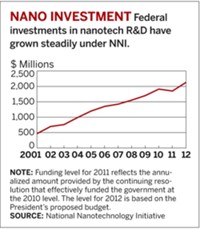Advertisement
Grab your lab coat. Let's get started
Welcome!
Welcome!
Create an account below to get 6 C&EN articles per month, receive newsletters and more - all free.
It seems this is your first time logging in online. Please enter the following information to continue.
As an ACS member you automatically get access to this site. All we need is few more details to create your reading experience.
Not you? Sign in with a different account.
Not you? Sign in with a different account.
ERROR 1
ERROR 1
ERROR 2
ERROR 2
ERROR 2
ERROR 2
ERROR 2
Password and Confirm password must match.
If you have an ACS member number, please enter it here so we can link this account to your membership. (optional)
ERROR 2
ACS values your privacy. By submitting your information, you are gaining access to C&EN and subscribing to our weekly newsletter. We use the information you provide to make your reading experience better, and we will never sell your data to third party members.
Business
Climate Changes after Nanosys Move
by VIVIEN MARX, C&EN NORTHEAST NEWS BUREAU
October 25, 2004
| A version of this story appeared in
Volume 82, Issue 43
Pulling an initial public offering, as Nanosys did in August, happens infrequently. When it does occur, the canceled IPO is usually a slight atmospheric disturbance that does not rattle investor confidence across an industry. In the young and carefully watched nanotechnology sector, however, Nanosys’ about-face felt more like a tropical storm that analysts and start-up executives can begin to assess as the winds die down.
Joshua Wolfe, cofounder of private-equity firm Lux Capital, wants Nanosys to succeed. After all, it is one of Lux’s portfolio firms. Wolfe says Nanosys is also one of the “bellwether companies” in nanotech, but he sees no need to rush an IPO. “I think Nanosys’ decision to wait for clearer skies in the market said very little about the company and everything about the market,” he says, noting that canceled IPOs were endemic this summer. Nanosys was one of 30 companies this year and one of 10 in August alone to pull its IPO, according to the website Edgar Online.
Nanosys envisions many potential nanotech applications. Founded in 2001, the company charted a course to develop applications in diverse fields such as electronics, memory, and surface coatings. Its partners include Matsushita Electric Works, Intel, and DuPont. The firm’s technology and intellectual property involve inorganic nanostructures made of materials such as silicon, gallium arsenide, or indium phosphide. It is this broad applicability that will make the company, in a positive sense, an “anomaly,” Wolfe says.
Comparisons to Nanosys seem to lend contours to a nanotechnology’s company’s self-definition. As Kevin Maloney, chief executive officer of the start-up QuantumSphere, says of Nanosys, “We have a different philosophy when it comes to R&D: They are more R and we are more D. ”
Scott Mize, a former venture capitalist and president of the nanotech think tank Foresight Institute, believes that while the Nanosys IPO might have been “a great boon” that could have helped several nanotech companies, it “might have had unintended consequences for the field,” he says. The fundamentals of the companies, the lack of products and revenue, would not have supported their stock prices, he says. “That would have been bad for everybody. Investors would have been turned off to nanotech stocks, and so in the long run it could have been very damaging.”
The public markets should be used for growth capital for companies with an established business model and a revenue stream, not as a form of venture capital, he adds. “What Nanosys tried to do was go back to the dot-com era when you could raise money on a company that was not ready, when it was too early,” Mize says.
“Pioneers get the arrows, and settlers get the land,” says Neil Gordon, who is a partner at Sygertech in Montreal and a nanotech consultant. Nanosys, as a company devoted solely to nanotechnology and made up of academic entrepreneurs, is a pioneer, he says. Among the settlers are such companies as DuPont and Boeing that have been extending into nanotech and integrating the nanoscale into their chemicals and materials without much fanfare. “The pioneers tend to put nano in their name and sometimes it helps and sometimes it hurts,” Gordon says.



Join the conversation
Contact the reporter
Submit a Letter to the Editor for publication
Engage with us on Twitter